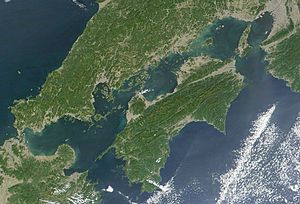Inland sea facts for kids
Inland seas are like shallow oceans that cover parts of a continent. They are also called epeiric or epicontinental seas.
These seas usually form when the global sea level rises. This causes the ocean to spread over low-lying land. They can also form when large dips in the land, called basins, fill with water and connect to the ocean.
Many shallow seas have existed inside continents throughout history. For example, much of North America was once covered by the Sundance Sea during the Jurassic period. Later, in the Cretaceous period, an even bigger sea called the Western Interior Seaway covered the land.
Today, the Baltic Sea is a good example of an inland sea. The Hudson Bay is also often seen as an epeiric sea. It is quite shallow, averaging about 100 feet (30 meters) deep. This is very different from deep oceans like the Bay of Bengal, which is 2,600 meters deep. Inland seas and epeiric seas sit on top of continental plates. However, inland seas are usually more enclosed.
Contents
Famous Inland Seas
Amazon Basin Sea
Long ago, the Amazon basin in South America drained into the Pacific Ocean. This was when South America and Africa were joined as part of the supercontinent Gondwana.
About 15 million years ago, the Andes mountains began to rise. This blocked the Amazon's path to the Pacific. A huge inland sea then formed. At times, this sea flowed north through what is now Venezuela. Eventually, it found its current path eastward into the South Atlantic.
Over time, this inland sea slowly turned into a massive freshwater lake and wetlands. The sea's creatures adapted to living in freshwater. Today, over 20 types of stingray live in the Amazon's freshwaters. They are closely related to stingrays found in the Pacific Ocean. The Amazon is also home to a freshwater dolphin. In 2005, scientists found fossils of a giant crocodile in the Amazon rainforest in Peru. This crocodile was estimated to be 46 feet (14 meters) long.
Mediterranean Sea
The Mediterranean Sea might look like an inland sea. However, it is very deep, reaching 17,280 feet (5,267 meters) in the Calypso Deep. The Mediterranean is actually a true sea that has been squeezed by the movement of the African and European tectonic plates.
It was once part of a much larger ancient ocean called the Tethys Ocean. This ocean surrounded the old global supercontinent of Pangaea. So, the Mediterranean is different from inland seas that sit on top of continental plates.
Black Sea
The Black Sea is a true inland sea. It formed because parts of the continental plates it sits on have slowly sunk over time.
Western Interior Seaway
During the Cretaceous period, a huge inland sea stretched from the Gulf of Mexico all the way into what is now Canada. This sea divided the continent of North America into two halves for much of the mid- and late-Cretaceous. These halves were called Laramidia and Appalachia.
This ancient sea was about 2,500 feet (760 meters) deep. It was also 600 miles (970 kilometers) wide and over 2,000 miles (3,200 kilometers) long.
Sundance Sea
The Sundance Sea existed in North America during the mid to late Jurassic period. This was part of the Mesozoic Era. It was an arm of what is now the Arctic Ocean. The sea stretched through western Canada into the central western United States.
The Sundance Sea began to shrink when highlands to the west started to rise. The sedimentary rocks that formed in and around the Sundance Sea are often full of fossils.
Images for kids
See also
 In Spanish: Mar epicontinental para niños
In Spanish: Mar epicontinental para niños



